You’ve probably heard by now about what’s styled the “kill switch” all new vehicles will be required to have, beginning with the 2026 models. You may not have heard that the “technology” is already in most new vehicles.
It is styled assistance “technology” – as for example speed limit assistance technology – which is but one of several kinds of “assistance” already embedded in almost all new cars and most cars made since about five years ago. Other iterations include brake assistance technology and lane keep assistance technology.
But the purpose of all of these “technologies” is not so much to assist as to control you.
The “assist” verbiage is to gull you into accepting being controlled – a little bit at a time – by not understanding that’s what’s ultimately intended. Until the time has passed to prevent it. Just the same as people were gulled, a century ago, into believing they wouldn’t be paying taxes on their incomes.
Only the rich would.
But how, exactly, does this “assistance” work? And how will it work?
Let’s start with what’s styled “speed limit assistance technology.”
It works by continuously keeping track of exactly how fast you’re driving at any given time and exactly what the speed limit is at the same time. It works via the GPS “technology” all new vehicles have that is aware of the vehicle’s speed as you’re driving that is then correlated with data about the road you’re driving on; specifically, what the speed limit is on that road. Which it knows because speed limits are part of what’s mapped by the GPS.
The two bits of data are compared and if you are driving faster than whatever the speed limit is, the car “assists” you via an icon built into the dash display that looks just like a speed limit sign – the number displayed being the speed limit of the road you’re driving on – that shifts from the white background with black lettering of the actual speed limit sign to angry red and flashing, often accompanied by a tone.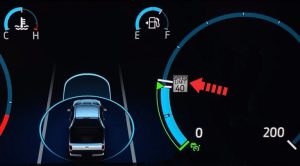
You know, like the kind used to train a puppy.
In Europe, where this “technology” has already been mandated, the “assistance” is more forceful. If the driver exceeds the speed limit, the car slows down. The accelerator pedal becomes harder to depress – or it pushes back. The driver can (for now) push down harder, to override the “assistance” – but the relevant fact is that the driver can be overridden by this “technology.”
In order to understand the how of that it is necessary to understand that pretty much all vehicles made since at least a decade ago have computer-controlled accelerator pedals.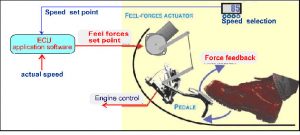
In the past, the accelerator pedal was connected to a cable and the cable pulled on the throttle when the driver pushed down on the accelerator pedal, giving the driver absolute control over engine acceleration. Push down on the accelerator and the engine would speed up, thereby causing the car to speed up.
But about a decade ago, it became common for new vehicles to have what’s called drive-by-wire throttle control. There is still an accelerator pedal – but it no longer controls the acceleration of the engine.
The computer that controls the operation of the engine does.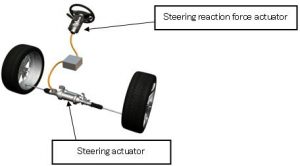
When you push down on the accelerator, the deflection is registered by sensors that feed the data to the computer, which tells the engine to accelerate (rev) accordingly. But it can just as easily tell the engine to rev less – or not at all. Push down as hard as you like – all the way to the floor. You have as much control over your car as the people riding in the backseat.
But you do have the illusion of control.
This illusion will be dispelled when “assistance” exerts the control it already has over your vehicle; you just don’t appreciate the fact.
You will, when the “technology” is updated to do more than “assist” you. Just like your phone – which isn’t really your phone, given the fact that you have no control or say over whether it gets updated. The vehicle you think belongs to you will be updated to operate in accordance with the owners, whenever they so decide.
Irrespective of your wishes.
And you won’t have to wait until the 2026 model year to experience the thrill of owning a vehicle you don’t control – if you already own a vehicle made during the past five years or so.
Like unseen cancer that’s been quietly metastasizing deep within your guts. assistance technology has been metastasizing into the “kill switch” you’ve been reading about that’s already here.
. . .
If you like what you’ve found here please consider supporting EPautos.
We depend on you to keep the wheels turning!
Our donate button is here.
If you prefer not to use PayPal, our mailing address is:
EPautos
721 Hummingbird Lane SE
Copper Hill, VA 24079
PS: Get an EPautos magnet or sticker or coaster in return for a $20 or more one-time donation or a $10 or more monthly recurring donation. (Please be sure to tell us you want a magnet or sticker or coaster – and also, provide an address, so we know where to mail the thing!)
If you like items like the Keeeeeeev T shirt pictured below, you can find that and more at the EPautos store!



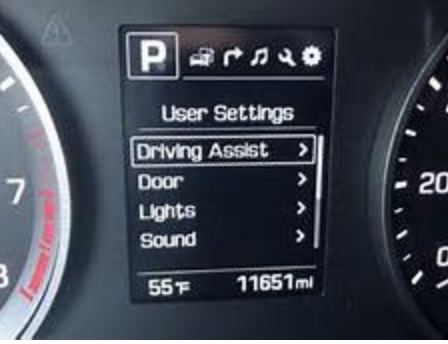

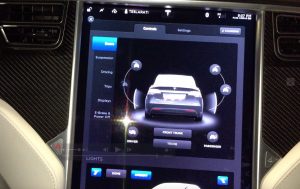




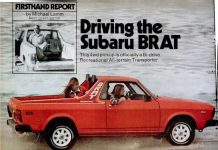


Happy OT: Smarter Every Day youtube visits man in Nebraska who built a see-through V-8. Very cool.
https://www.youtube.com/watch?v=TbhF7jTLlG4
Quid pro quo –citizens should be able to activate a kill switch on police cars, politician’s cars, police helicopters, bureaucrat’s cars, government surveillance manned & unmanned vehicles, etc. I won’t hold my breath on that one.
Let’s not forget that safety is merely their EXCUSE to push/mandate these technologies. The real REASON is to make driving a chore and for you to not to want to do it and to make it so you can’t do it when they say so. Driving is freedom and they hate you for your freedom and think that you do not deserve to be free. The are pissed that when they told you to stay home, you didn’t. Next time you will. You’ll have no choice.
And they told us the reason the Islamic terrorist hated us was because of our freedom? So I assume we are safe calling these Psychopaths In Charge terrorists as well?
Technically, they told us that the perpetrators of 9/11 hated us for our freedom. And since they perpetrated the whole thing, they weren’t lying. It was an event to expand their powers over us and it worked brilliantly.
I predict this will be unpopular, and it will cause far more accidents than it prevents.
There is no question it will cause more accidents than it prevents, it probably already is.
But don’t worry, its not a bug, its a feature.
Hey Eric, looking at that new CX90 Mazda, can the lane assist be turned off, and can it be kept off, or is it a turn it off on every restart?
For fun I filled out the info to get a trade quote on the Jeep, it was like sending up a signal flare! Texts, email, voicemail “your trade is in high demand, send us pics or schedule a time with us! Like everything now the base model is non existent their cheapest CX90 is 41k a decent one with captain chairs 2nd row is 50k.
I had been looking at tha CX 30 Carbon Edition for my wife and I. We are retirement age empty nesters, though I still drive truck long haul as I have for many years. I believe that the Mazda’s are as sound mechanically as one can get today. The engine and tranny are used throughout most of their models and are time proven to be reliable and sound (2.5 L; 6 spd auto). I found a new ‘23 Model 3 in a Kansas City Mazda dealer on line in basic trim at a very good price point, so I rented a car and drove there to purchase. My wife is happy with this car, the basic trim level is equipped very well, and the price point was outstanding. Nice running car, fuel mileage has averaged 38.3 in combined driving of about 1000 miles so far. The dealer in Kansas City was good to work with and did not attempt to add all manner of dealer markups to the otd price. I had to take my time and I shopped around on line in a 500 mile radius from home. I learned a lot from CarEdge.com a daily YouTube site with much good info. Look up CarEdge, father and son and it is a wonderful site. I used some knowledge that I gained from CarEdge as I went car shopping. There are some good honest people to work with out there, you just have to take your time and use wisdom.
Also the Mazda’s don’t have the asinine auto stop/start system when you’re at a red light-thereby avoiding that high cost maintenance issue down the road. Wish you well Sparkey.
Thanks! 5 years ago daughter and I drove 100 miles over the hill to look at a gently used Mazda 6, bought it on the spot and drove it home, she needed a fuel sipper commute car at the time. As usual, and you point out, they just work day in and out with normal maintenance. She’d had two Mazda 3s in the past same great reliability. We’re a car nut family and the only fun to drive East Asia rigs are from Mazda in our opinion.
Toyota is Japanese for boring. Honda / Acura = fragile. She’s also got a 2009 MDX that’s great for comfort and precise driving but man, it’s not aging gracefully. They were overseas with it, got the call for a A/C pressure switch that was unobtainable in Germany. Full up brake replacement twice, then a third time last year now that it’s home. Two years ago the power windows quit, that was the wire loom between the body and drivers door (thanks YouTube for the diagnosis). Struts last year, what fun. In and out twice to fix the top mount clunk. Stab links and tie rod ends this year for another clunk fix. We do love that Acura but it’s not an easy keeper. Meanwhile my 2003 Ford Escape motors on with zero issues, humm probably due to being a Ford/Mazda joint venture, that thing literally drives like new. Zoom zoom indeed!
Dang, Sparkey, you seem like a flat asphalt warm climate kinda guy. “Toyota is Japanese for boring.” ???
I guess you’re not into taking Taco’s & FJ’s offroad? They’re anything, but.
…Not that there’s anything wrong with being a flat asphalt warm climate kinda guy.
In my Yota training days, I knew this guy who used his Taco to jump rivers. …
Not a stream, nor a creek. …A river.
‘The Dukes of Hazzard 1979 – 1985 Opening and Closing Theme’
https://www.youtube.com/watch?v=67gig0f4HLo
I’ll give Mazda credit for escaping the curse of designing cars in a country where the national speed limit is 37 MPH
Okay,…What?!
Are you saying the national speed limit is 37 MPH in Japan?
…? …You really think that?
I did a double take.
It’s 37 m.p.h on, “ordinary roads”. Do you know what “ordinary roads” are in Japan?
It’s nothing – I mean, Nothing – like the ordinary roads here in America.
On expressways, the speed limit is 100 km/h which is equal to 62.14 miles per hour, or, about the same as here on the Interstates.
That said, I’ll grant you that, just like here, it’s a curse to have any speed limit at all.
Meanwhile, back here but out west:
https://www.nationalspeedlimits.com/speed-limit-in-utah/
https://www.nationalspeedlimits.com/speed-limit-in-idaho/
Good stuff, Dr. Grandpa!
I agree with you about Mazdas. They are reliable, like Toyotas – but more fun to drive. Probably the best transportation ever made is a Camry or a Corolla. But Mazdas are close – and better in many ways. For example, the Miata. This is a real-deal sports car that you can use regularly as a weekend track day car and still drive it to work every day for 15-plus years. It’s astounding.
Heard somewhere the Miata is the most raced car in the world.
Hi Rich,
That makes sense to me – in re the Miata. In production since 1989 and more than a million made. For a sports car, that’s astounding and speaks to the car’s brilliant design.
Governor Bill Janklow was driving his car on a South Dakota highway, ran a stop sign, collided with a motorcyclist and caused a fatal accident. He had been drinking.
100 days in jail. In South Dakota, you can drink and drive, cause a fatal accident and 100 days later, you are free to go.
Kill Switch Bibi is responsible for 11,000 Gazan deaths, murder, times 100 is 1,100,000 days in jail.
Has to be some justice in this world. Enough to drive you to drink, as it should.
On YouTube, they have videos of vehicles falling apart while moving. One car lost a wheel, another car in the lane left of the car that lost the wheel hit the wheel, went airborne and flipped midair to boot.
Wheel bearing probably failed, accidents happen with nobody at fault.
Not much you can do except to call 911.
Here we go…
https://www.ntsb.gov/news/press-releases/Pages/NR20231114.aspx
Red line in the sand stuff for me for sure. I will make sure I test drive any new vehicle purchase to make certain this ‘limiting’ stuff does not exist or work. If so, I will then drive old and just keep fixing, as much as I would dislike to do so.
I also wonder if the ‘aftermarket’ coders will be able to deal with this stuff?
I hope so as well! There are plug in modules to prevent the Auto Start Stop from activating. I’d be great to have a “box” to over ride the rest of these annoying features.
Harley got in a jam for selling and installing parts that added performance but not EPA compliant. So, now you show up with unapproved mods for a warranty fix you can be denied. The onboard engine control records what tune has been downloaded, and if a non Harley tune is detected during service the warranty is immediately void. It rats you out when the dealer hooks your bike up to the Harley “mothership” computing system. I’m sure it’s in place at the car and truck dealers too.
Hi Sparkey,
And that’s exactly why I would never buy such a bike. If I had to take any of my bikes to the shop, the bike would not squeal on me to the shop.
I’m out of warranty now so “freeedooom!” for me on mods. Thankfully the M8 motors are plenty zippy stock config which is a shocker compared to the old stuff leaned out choked off slugs. They even opened up the exhaust so it sounds great with stock muffs.
The irritant is the ABS module requires the brake fluid flush every two years. To do it properly requires ABS activation while bleeding which of course is via their proprietary computer.
Man, this is… for a motorcycle,… to me,… just… I dunno,… (insane?) or sumthin’:
“The irritant is the ABS module requires the brake fluid flush every two years. To do it properly requires ABS activation while bleeding which of course is via their proprietary computer.”
Or, maybe I’m just overwhelmed by all the maintenance requirements every machine around me has? Idk.
…Maintenance’d, to death. $$$$$
“of course is via their proprietary computer.” … can you see me shaking my head?
That said, I imagine it’s a fine ride & worth the effort. …Didn’t want ya to think I was slamming you or your machine, or anything.
Hi Helot,
Yup; crazy, isn’t it? I can bleed any of my bikes’ brakes in just a couple of minutes with exactly two tools: A screwdriver (to remove the lid of the fluid reservoir) and an 8 mm wrench to loosen the bleed valve on the caliper. Squeeze out the old fluid (via the brake lever) then close the valve, refill the reservoir and done.
No ABS for me, thanks.
Bikes – like trucks – used to be designed to be simple because most bike owners wanted that. Now they are becoming complex – like new trucks – and they can keep both.
Sparkey,
“The irritant is the ABS module requires the brake fluid flush every two years. To do it properly requires ABS activation while bleeding which of course is via their proprietary computer.”
I find that hard to believe. You should be able to bleed the brakes yourself without the scan tool, I do it all the time.
I think they’re blowing smoke up your keester.
Well, that’s the debate in the Harley blogs. Some say, like the cars, just get moving on a slippery surface and hit the brakes hard to activate the anti lock then re bleed to get that bit of fluid that was in the ABS fully out. Others say that won’t work, ABS has to be active during the bleed to really move that old stuff along and out. It’s a hundred bucks and I don’t have to worry about me spilling brake fluid on the paint. The final solution would be to pull the ABS and run non ABS brake lines, screw ‘em and their little yellow warning light!
“pretty much all vehicles made since at least a decade ago have computer-controlled accelerator pedals.” Eric, this is at least partially wrong.
To most people it won’t matter and the meaning will be clear enough, but to a guy who has spent the last 30 years designing and programming automated system it rubs me wrong.
The loud pedal (hot rodder argot) is only controlled if it has the force feedback you describe, something taken from cool technology like game controllers that make the game more realistic, and robotic surgery. Up until pretty recently there were computer controlled THROTTLES and the pedal was a passive sensor. Which had enough problems and caused my son to have an accident with my Chevy pickup a few years ago.
Sorry to be that guy, but it just rubbed me wrong. Otherwise, keep up the great work
You’re missing the forrest from the trees.
As soon as the throttle became disassociated from a cable, it becomes possible to control the vehicle despite your input on a passive pedal.
In the most benign sense, this simply means your car can be made to not exceed the speed limit – despite your (possible) intention to do so.
That was ALREADY a feature of a 2011 Ford (con)Fusion that I made the mistake of leasing (I was still married, my now “ex” wanted the car and it escapes how the hell I let myself get talked into a lease). It was limited by the factory to a top speed of 75 mph, since it was still THEIR ride, not mine.
Never again.
I’ve managed to avoid a few incipient accidents over the years by being able to stomp on the gas and swerve abruptly; wait until a dog or kid runs out in front of you and the car prevents you from taking fast evasive action. Line up the lawsuits.
Wow: You gotta go way back then, to get a car that a) has no anti lock brakes, b) has a direct connection to the throttle (e.g. cable), c) direct mechanical control over the steering. I’ve had Fords and Subarus, so for Ford trucks, the cable to the throttle was discontinued in 2003. The Subaru 2005. Lack of ABS means going back to the early 90’s! I think “steer by wire” is a relatively new thing.
So match up any of those three, with a connection from your cell phone into your car and viola! There’s the control path.
2000 and older is mostly analog mechanical. Otherwise, first step is selectively jamming onboard GPS with analog on/off switch or removing its hardware. Second step is recoding onboard nannytech as possible. Way beyond 97% of neurotypical humans unfortunately.
Sounds like a great new cottage industry to my 139 processor. But most of us have retired or sold out.
Automobile law is centered around the driver’s actions and intent. Cops ask the entrapping “Do you know why I pulled you over?” questions. If your car is throwing a hissy fit every time you go over the PSL it gets much harder to claim ignorance. Cha-ching!
Pay attention to the aviation industry. Pretty much all military and most commercial fixed wing aircraft have been fly-by-wire for decades. As Moore’s Law makes the stuff cheaper, the technology is filtering down (and up from small drones) into civil aircraft too. ADS-B requirements, started out as an upgrade to old radar systems, allow other aircraft to see other aircraft on their cockpit display, and big commercial aircraft are required to have Traffic Alert and Collision Avoidance System (TCAS), which is designed to automagically take control of the aircraft if it determines a collision is eminent (if the pilot in command has yet not taken action).
Most people think that the only speed limit in the air is “don’t break the sound barrier over land” but actually there are plenty of speed limits in the sky. If you’re in controlled airspace you are required to maintain whatever speed ATC instructs you to fly, not to exceed 250 knots. If you’re in a big headwind and your little Lycomming can’t generate the thrust necessary to maintain speed you can let ATC know and they’ll move you out of the way. If you don’t follow instructions you’ll have to have a conversation with the FAA. Too many conversations and you’ll be grounded.
https://www.flyingmag.com/aircraft-speed-limits-explained/
The point is, everyone is under the watchful eye of ATC all the time. And your aircraft is broadcasting your position and speed at all times to anyone with a radio that can pick up the signal. Useful for situational awareness, yes, but also a pretty useful tool for enforcement too. In the case of aviation the rules usually have a lot of input from pilots and recommendations from after crash RCA reports. In the case of automobiles, there’s much less transparency about how the rules are made.
Ahhh you get it! Garmin or Dynon?
More like DJI or Pixhawk (or Skydio). Big planes are out of my budget.
From a paper presented by KEA Technologies in April 2023 at the 27th ESV [Enhanced Safety of Vehicles] Conference:
‘Exploratory research in earlier phases of the [DADSS] program established the feasibility of two sensor approaches, breath- and touch-based, for in-vehicle use.
‘Currently the DADSS program is focused on transitioning the latest generations of consumer breath and touch sensors from research to product development.
‘Numerous parallel research programs continue including sensor development, development of calibration processes, materials and instrumentation that will verify the technologies are meeting these elevated performance specifications, human subject testing in conditions that replicate those likely to be experienced in the real world, and real-world field trials in diverse settings.
‘The goal for DADSS technologies is commercialization.‘
https://www-esv.nhtsa.dot.gov/Proceedings/27/27ESV-000293.pdf
When a vendor states in April 2023 that they still need to transition sensors out of research into product development, and then to commercialize the sensors, it is very clear that the sensors will not be ready in two years for inclusion in 2026 vehicles, if ever.
Although drive-by-wire functions are incorporated in existing vehicles, without a hardware sensor installed, the vehicle cannot activate a kill switch because of alcohol detection. The detection function is missing.
The handwriting is on the wall: the MY 2026 deadline for alcohol-detection kill switches is not going to be met.
Don’t believe me? Contact the paper authors, Zaouk [the CEO] and Willis at KEA Technologies in Massachusetts, and ask them.
Hi Jim,
Alcohol sensors are one thing. The Biden Thing has decreed that driver performance will be monitored and considered “impaired” if it is outside acceptable (to the things) parameters. I can personally attest that this sort of “technology” is already in existence and being used to “correct” driver performance.
It will become more aggressive and intrusive – wait and see.
This gets into the weeds of who’s in command of the vehicle, and who’s responsible in an accident. Will a vehicle automagically pull off the road? What happens if there’s no berm or breakdown lane? How far will the vehicle travel under its own control to find a safe spot to stop?
If it pulls off in a bad spot and causes an accident who’s responsible? Or has an accident while overriding the driver? Of course it will be the driver, since he was “impaired” and chose to drive anyway. Won’t be the programmer, or the manufacturer, or the Congress.
How many years will the manufacturer support the system? All modern computer systems have bugs and over time software is optimized. There will be software updates, but for how long? If a manufacturer stops updating after an arbitrary period of time, will an accident determined to be due to a software bug make the manufacturer liable even if they end of life the vehicle?
I remember going to car shows in the 1980s and seeing all those classics and antiques from the 50s and 60s. I remember thinking that outside of Porches and Corvettes, no one was going to hang on to the cars of the my youth. To my surprise people did, although I don’t see many Omni 024s on Bring a Trailer. Will that even be possible with the cars of the 2020s and 2030s? Will anyone want them 50 years from now?
Hi RK
I can’t imagine that there will be any kind of collector car market in 50 years. Collector cars seem to be mostly owned by middle aged and older guys, and they are usually the cars that were “cool” in their youth. Kids today don’t care about cars, so I doubt they’ll have any nostalgia for them in 50 years. Even if they do, I don’t see how it’ll be possible to restore or maintain them. While not cheap, it’s also not difficult today to restore a 50 year old car from the 60’s or 70’s. With all the software, electronics, computers, gizmos and gadgets and plastic, I can’t fathom how it will be possible to rebuild and restore say, a 2024 Corvette or Lexus LC500 50 years from now.
I’m not so sure. Most of us old timers think the Fast and the Furious franchise is a big joke but it remains popular and apparently profitable. Driving games are still a mainstay of the industry. Anecdotally, my nephew’s first purchase when he got a job was a new bright green Jeep Wrangler. And there are plenty of under 30 people van life’ing. They consider mobility and travel a big deal.
Maybe they aren’t lusting after cars as objects to be owned but tools to be used. But perhaps that’s more due to the outsized influence by collectors and not having access to storage spaces too. That will probably change over time when (if) the silent and boomer generations pass through to the eternal realm and their suburban homes begin to be dumped on the market (as long as they aren’t destroyed in a Detroit-style collapse).
The cars of the late 70s, 80s and early 90s were mostly disposable junk. They are collectible today because a few were cool (Rampage, Shelby GLH, Allante, Reatta, 5.0 Mustangs) or because there are simply none left and they are non-electronic. I had my eyes opened recently selling a couple of early 80s VW Rabbits- I knew the diesel pickup would sell well, but the gas coupe was surprisingly easy to sell for a good price. And decent Rabbit GTIs I have since learned are bringing 25-30k.
You’re right Ernie. Cars from the 60’s and early 70’s were junk too. Believe me, I was there. But they were mostly metal and mechanical parts, so they can be pretty easily repaired if you want to. But, 50 years from now, how ya gonna repair a fried body control module that hasn’t been made in 45 years and was written in a software language that nobody has used in 40 years? Kind of like trying to get info off of an 8 inch floppy disk that was written in FORTRAN today. Good luck with that!
Shelby GLH on avgas could smoke tires long as gearbox could take it. Thanx for the memory.
My 2yo daughter had partially disassembled that talking dash Daytona turbo z rear interior halfway into our test drive. Lee Iacocas Citation had the shite bendix avionics too. Go figger.
It will go beyond well-intentioned efforts to deter “drunk” or “impaired” driving, and will then “progress” to deterring “fatigued’ driving. Then it will be used to prevent your ride from being used for something THEY don’t want…like, for example, Orange Man is holding a rally, in, say, Reno, NV, and I want to drive there from my suburban Sacramento home to attend. ONLY…I’m on a “Trump Supporter” list maintained by the “FIB” (which should be their acronym, not “FBI”), therefore a “domestic terrorist” and/or “White Supremacist”, so, “magically”, my ride shuts down once I get to Truckee, and won’t restart until the Trump rally is over. A ground version of the “No Fly” list, used not simply against those that made trouble on commercial airline flights, but those the PTB wanted “grounded”.
It should be kept in mind that internal passports were a huge part of controlling the peoples of the former Soviet Union. Leaving town was a PRIVILEGE in the “Worker’s Paradise”.
@Eric – We had a new BMW X5 as a rental last week in Wisconsin, and the cruise control would not “Set” at any number than the speed limit. Pressing the button at, say, 77 would result in the car setting the number at 70.
It was possible to activate cruise control for a number higher than the speed limit using the rocker switch +/- after pressing Set, but that motion was a bit awkward.
I assume that GPS was at work for retrieving the speed limits, but I’ve heard of optical systems in cars which will read the standard format highway signs.
That must have earned some engineer a bonus for the patent. The more software patents the better at the automakers these days — that’s what I believe really drives development of these ‘features’.
I guess I’m keeping my 2016 Honda Fit (aka the golf cart) until it or I die. It may not accelerate fast but at least I have control over its non-acceleration.
So my purchase of a 2012 Boss 302 on Monday was actually a really, really good move! Thanks Eric! ;).
Definitely, Steve!
Isn’t it great to own a car that isn’t controlled by someone else?
The recent dual sport bike article is golden advice !
Thanks for your work.
You bet, Rain – and thanks for the kind words!
Ford CEO Jim Farley’s daily driver is reportedly a 2012 Boss 302.